Sameer Al-Doumy | SYRIA | The Will To Survive | An Exclusive Interview

Sameer Al-Doumy/ AFP © All Rights Reserved.
Sameer Al-Doumy is a Syrian photographer born in 1998 in the city of Douma. He worked on covering the war that has been devastating his country for the last 7 years. He began his media work as an activist in the middle of 2011 as the peaceful Syrian uprising began. In the middle of 2012, the Syrian regime forces besieged Douma from all sides and attacked the city. In 2014, Al-Doumy became interested in photography and started browsing the internet for tutorials to learn more. He developed his skills by self-training, without any academic training.
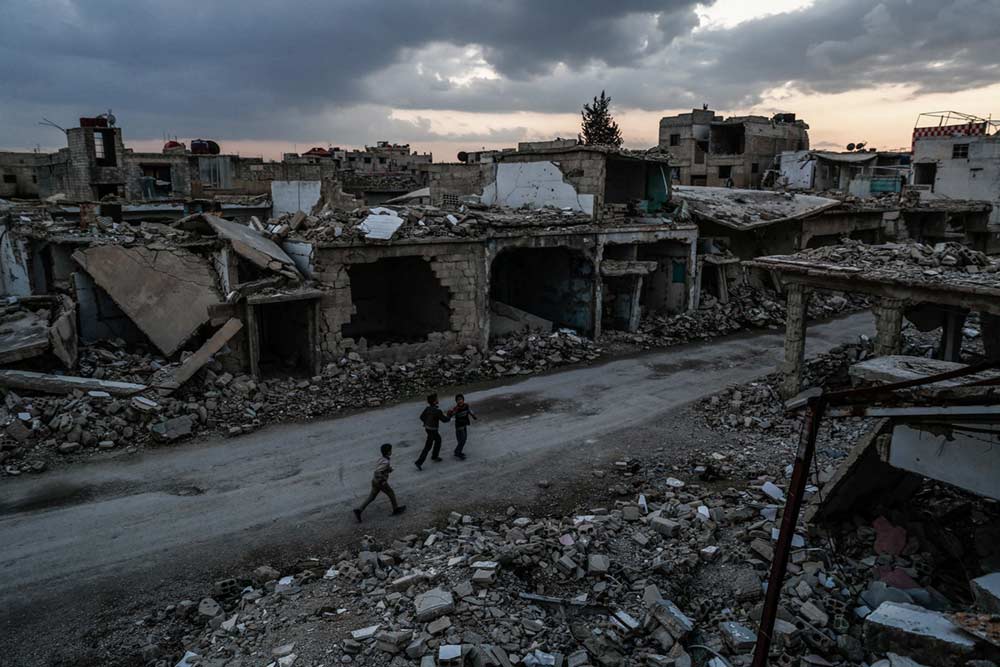
Sameer Al-Doumy/ AFP © All Rights Reserved.

Sameer Al-Doumy/ AFP © All Rights Reserved.
In late 2014, he began working for Agence France-Press as a freelance photographer. Since then, he has won several renowned international photography awards for his work. Believing in the importance of showing the truth to the whole world, amplifying the voice of the vulnerable people, documenting the injustice and the human rights violations, spreading news, and sharing reality: those were the main reasons that pushed him to carry a camera and start taking photos. He believes in photography as a way to change and to achieve justice, and this is what motivates him to keep working in such a harsh situation, giving him the strength to continue his quest.
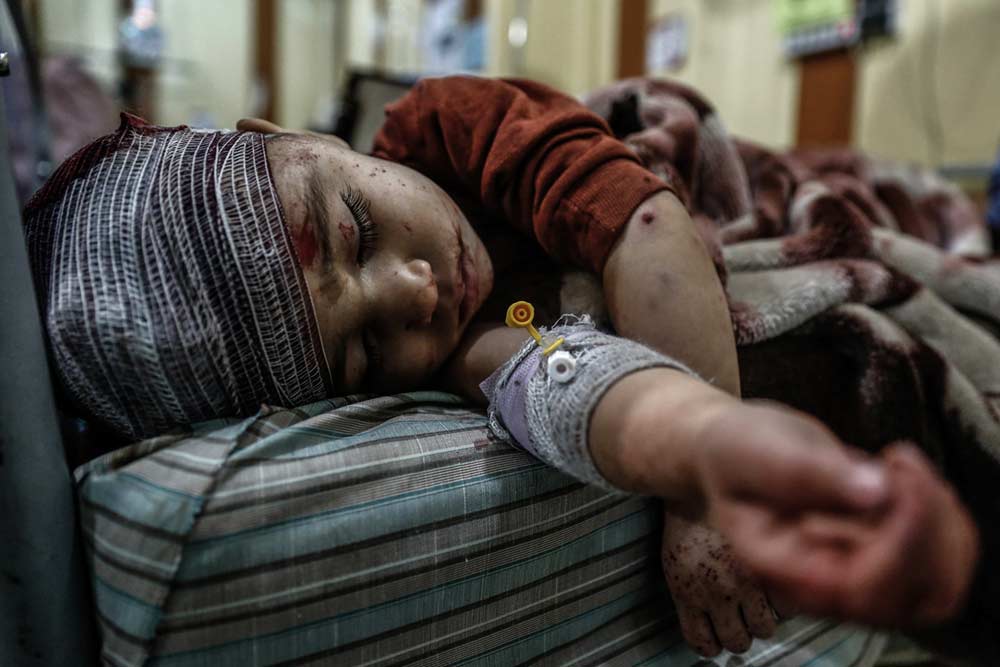
Sameer Al-Doumy/ AFP © All Rights Reserved.
An Exclusive Interview With Sameer Al-Doumy
SYRIA | The Will To Survive
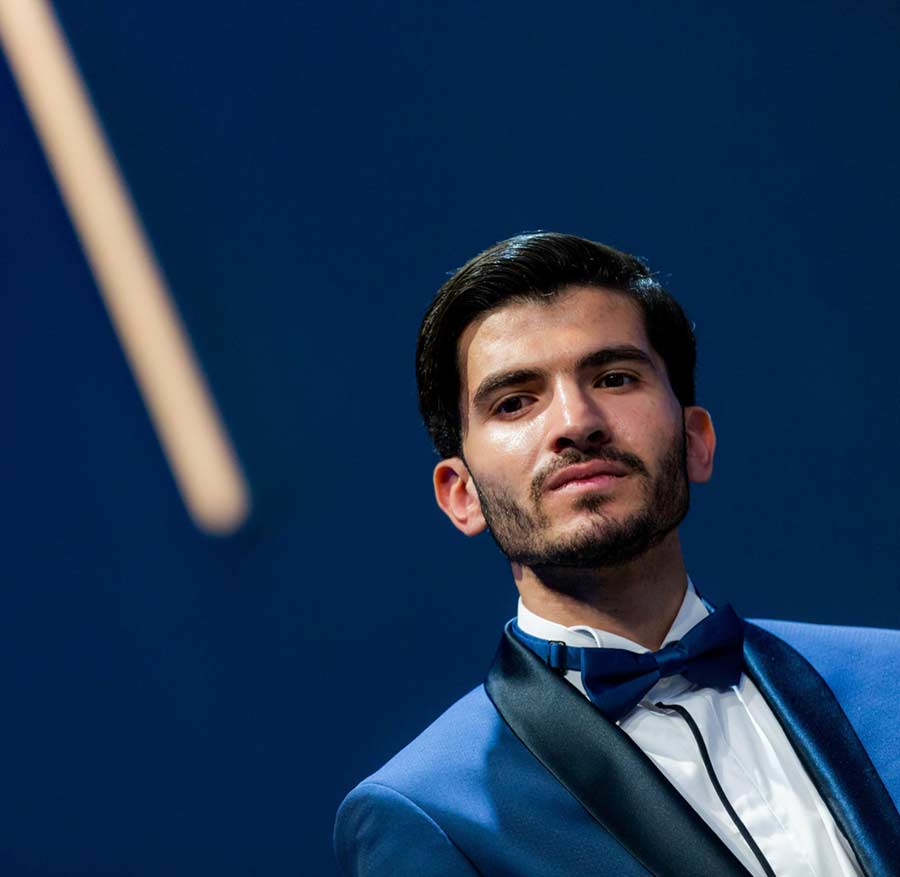
© All Rights Reserved.
Lens Magazine: Thank you, Sameer, For the opportunity to have an interview with you. We are honored to feature your work and to expose the difficulties of everyday life in the heart of Syria. It’s a painful, heartbreaking situation.
Let me start from the beginning. You were born in Douma, a city that suffered a chemical attack in April 2018. In that attack, 70 people were killed, and many suffered from the attacks that came afterward. Can you please share with our readers how were life before this attack? What was it like, for you, to grow up in pre-war Douma?
Sameer Al-Doumy: I wasn’t staying in Douma in the last chemical attack on the city – I left a couple of months earlier. However, I had friends and family members who lived through this brutal attack which came after 3 months of heavy bombardments. There were no food and medications present at the time. For over two months, people were not able to see the sun, as they were forced to leave in basements where they were seeking protection. The chemical weapon usage was when the Russian forces and the Syrian regime had just offered an agreement to the opposition fighters, which led to forcibly displacing everyone towards the north of Syria, which is under the opposition’s control. Under such pressure of starvation, bombing, and chemical attacks, a lot of people had to leave my city, Douma, including my family and friends – leaving everything they used to own behind.
Personally, I have lived and witnessed the chemical attack that took place in my region of Eastern Ghouta on 21st of August 2013, where more than 1400 people were killed, mostly children and women.
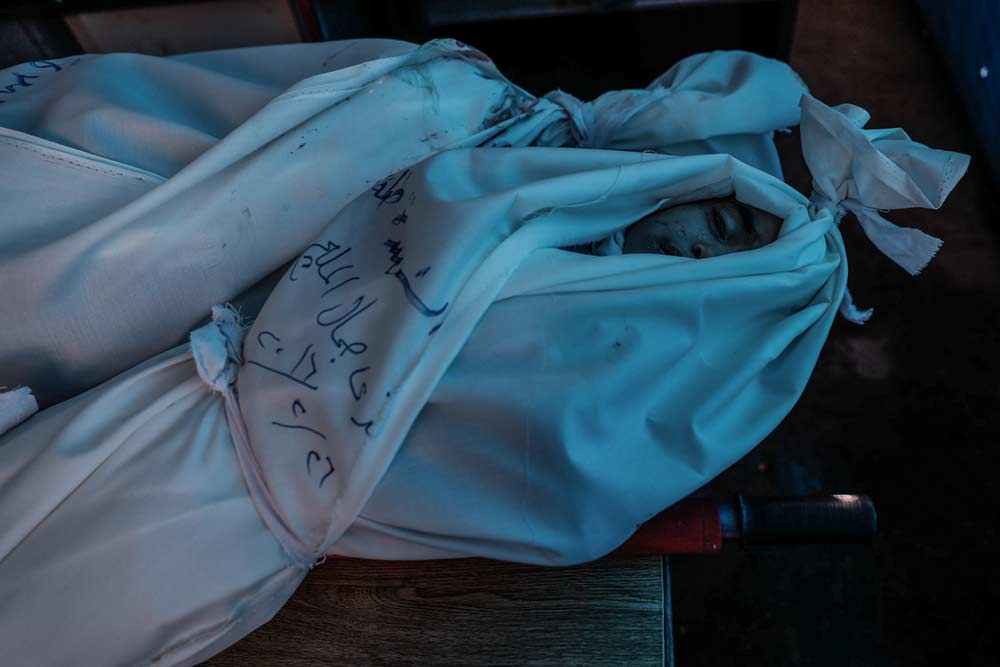
Sameer Al-Doumy/ AFP © All Rights Reserved.

Sameer Al-Doumy/ AFP © All Rights Reserved.
L.M: How did you become a leading war-zone journalist? What is your background in photography?
S.D: I have started my work as a media activist in the middle of 2011 as the peaceful uprising began in my country. Back then, people went out in demonstrations demanding peacefully for more equality, freedom, and justice. They did not even demand for the regime to be taken down, yet the Syrian regime replied by shooting demonstrators directly, killing dozens on the spot. I was helping my older brother with documenting those human rights violations by videos. After a couple of years, I became more interested in photography, but as the siege of Eastern Ghouta was an uprising, I did not have access to proper education. Thus, I was mostly dependent on watching videos on the internet and learning by myself. With time, I gained enough experience and started working for international news agencies like AFP. I even won several photography awards, such as the Istanbul Photo Awards’ International Photography award.

Sameer Al-Doumy/ AFP © All Rights Reserved.
L.M: Since March 2011, Syria has been embroiled in an armed conflict, with a number of foreign militaries involved. In your photography work, it’s important for you to expose the pain of the common people, families, children and elderly that suffer from the unbearable pain that this war is causing. Can you please tell about the daily life of Syrians living in their war-torn country? What was it like for you to live there in the past year?
S.D: First of all, I would like to clarify something: the Syrian regime was the first to had used gunfire against his own peaceful people who were demanding for justice, equality, and freedom in a peaceful way, carrying olive branches and flowers. Then, things began to accelerate as soldiers in the Syrian regime army refused to shoot civilians – they were called The Dissidents at first.
With time, they started to get bigger and bigger and created a group called The Free Syrian Army. Its main mission was to protect the demonstrators from the Syrian regime. After a couple of years, the Syrian regime started a siege on Eastern Ghouta, which became out of his control as some kind of punishment. The siege continued for over 5 years. Food, medicine, and fuel supplies were blocked, in addition to the inability of people to get in or out of the area. People’s life became limited to trying to find ways to survive and to stay alive. They started finding alternatives for food, medication, electricity, water, etc.… On top of that, they were suffering from the daily bombing that was never spared from them. Every day, bombs fall, people die, others get wounded, and buildings get destroyed. With each airstrike, a house loses someone, a father, a son, a child, and someone precious.
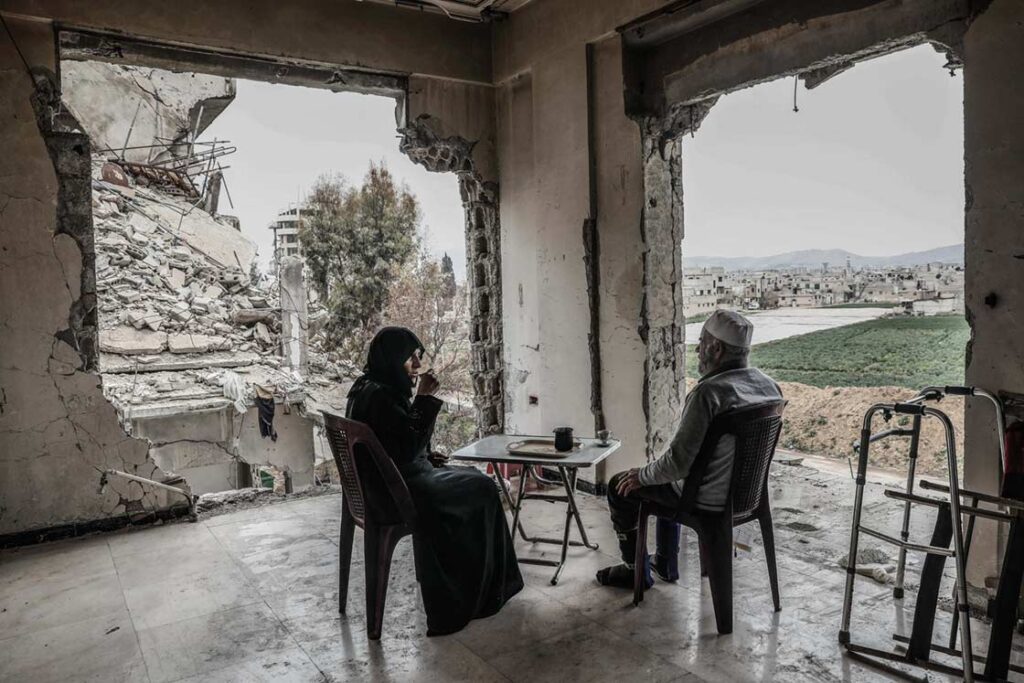
Sameer Al-Doumy/ AFP © All Rights Reserved.
L.M: At what point did you leave Syria and move to live in Paris?
S.D: I had to leave Syria on 14th May 2017, during the forced displacement campaign by the Syrian regime on al-Qaboon neighborhood. When the whole area was destroyed after three months of heavy shelling that ended by forcing the people to leave everything behind and move to the northern area of Syria, which is under the opposition control in order to survive and stay alive. After a difficult month of trying to be smuggled, I headed to Turkey as there was no legal way to get out. After my arrival in Turkey, I started to learn English and prepared my papers to move to France, which was legal by airplane as I got an asylum seeker visa.
L.M: Tell us about your family, your beloved ones that stayed in Syria. What is their situation?
S.D: I have a big family, actually. I have five brothers and five sisters. I’m the youngest. I still have two brothers and a sister in Syria, living under very difficult heavy bombing. That is, in addition to the lack of basic services. The most exhausting thing is that now my parents are in Turkey with some sisters and brothers. I also have a brother in Saudi Arabia and a sister in Egypt and no one can see the other due to document issues! It’s like a dream for me to gather with my family again.

Sameer Al-Doumy/ AFP © All Rights Reserved.
L.M: You are considered a very influential activist, documenting human rights violations in your hometown via videos and stills. Fortunately, you had managed to escape these terrors and currently live in France. Is there a problem for you to cross the border back to Douma these days?
S.D: As I am a political refugee in France, I do not have the right to go back to my country – there is a serious threat to my life by the Syrian regime due to my media activities. The Syrian regime does not want the world to see the crimes that its forces are committing, and this is why its biggest enemies are journalists documenting these human rights violations and crimes against humanity. There is no space for freedom of expression in the area of the Syrian regime, and many journalists have been assassinated because of their activities. On top of that, the ones who got killed directly are considered kind of lucky, as they were spared from being sent to the prisons of the Syrian regime; these places have a terrible reputation of usage of torture methods. Only a few survivors make it out of there to tell us about the horrors of being there. Mostly, people die while being tortured over there.
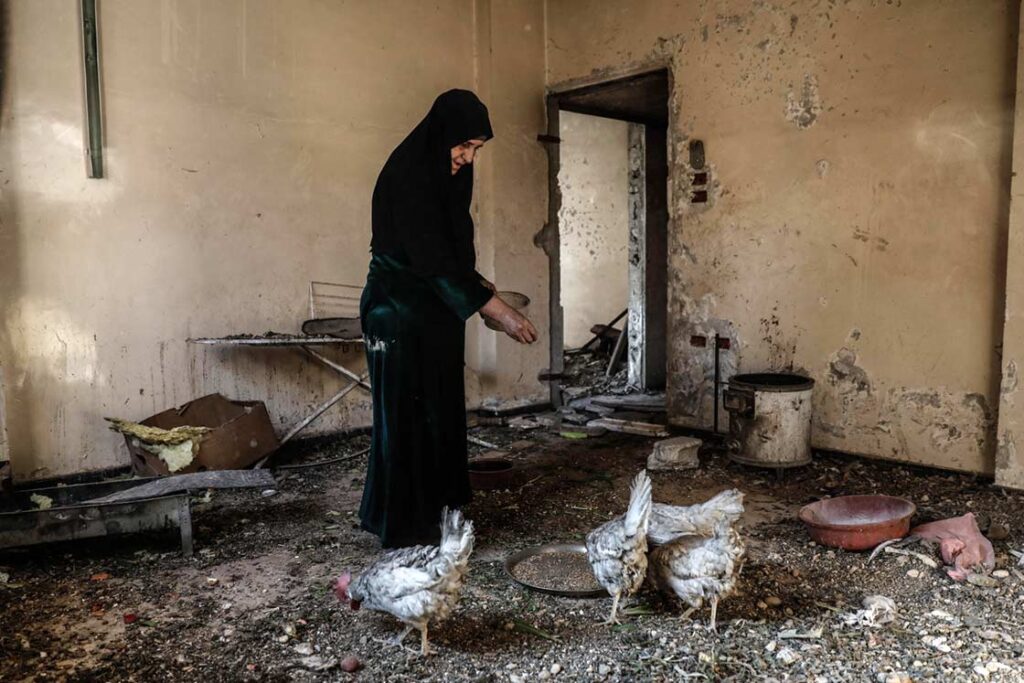
Sameer Al-Doumy/ AFP © All Rights Reserved.
L.M: Do you see a better future for the Syrian people? What do you think the future holds?
S.D: For some Syrians, I think the future could be better as some have the opportunity to leave to countries where human rights are respected so that they can practice some kind of democratic life and, more importantly, have access to proper education. I saw most of them are studying and preparing themselves well, which could benefit their homeland, Syria, in the future. Nevertheless, it is not easy at all for them to do so, as they live through such a tough experience in exile. Then again, I think it will be good for the future, as Syria will need those educated people who have plenty of differences well-sharpened experiences.
L.M: On your website and blog, you feature excellent documentary series about touching subjects, including the story of sixty-two years old Um Mohammed, a wife and a mother. She got shot in the abdomen by a Syrian government Sniper and her house was destroyed. Can you tell us more about this experience, documenting the situation of Um Mohammed and her husband?
S.D: Spending time with this sweet woman was an extra experience for me. During almost a month that I spent with her I was getting more and more inspired and empowered by her will and determination. Um Mohammed did not give up in one of the most difficult situations as her injured husband needed her help. She managed to improve herself and learn despite her age and all of her responsibilities. At first, I was shy of taking photos, but she has such a beautiful soul that makes you feel very comfortable to talk to her, and this is how I started to take some pictures from time to time as I do not want to be annoying with my camera. I tried to be kind of invisible, which was not an easy mission as it took me a long time.
Um Mohammed was such a sincere lover, she did not give up on standing by her injured husband despite everything. In my opinion, the resistance of Um Mohammed – her devotion, determination, and desire to live and learn — is representative of real Syrians.
L.M: One of the most difficult to watch series of images on your blog, “24 hours in war”, features a heartbreaking image of injured children and babies.
As always, the children are the main suffering souls in the war zone. It takes a lot of strength to document these rocket attacks and terrible losts. What gave you the strength to do the work that not many photographers are capable of?
S.D: Documenting such painful moments was not easy for me, but the same reason that was making it harder for me was what gave me the strength to continue through. The most difficult thing for me is that the people who I am taking photos of are my own people; they are my family, my neighbors, my friends. It was extremely hard to take photos of them in such critical moments. However, it was what gave me the strength to continue – the pain of my own people, the pain I portray in my photos, is mine, too. Therefore, I was hoping that those images might help change that bitter reality, or, for the very least, the world will be able to know, to witness the history of horror in Syria as it develops.

Sameer Al-Doumy © All Rights Reserved.
L.M: Let’s focus on the siege. After the government lost control on Eastern Ghouta, it had tightened, and life there became unbearable. The Syrian government has imposed a severe siege on the area as a kind of punishment, attempting to regain control over the area by starving and bombing its people. Primarily, the regime has restricted the movement of civilians, confiscated food, and arbitrarily deprived civilians of electricity and water. The most difficult siege period began in late 2013, when the Syrian regime and its allies imposed a complete siege on Eastern Ghouta. In August 2013, the regime launched a massive chemical attack on the area. More than 1,400 people were killed, most of them civilians. Can you tell us more about the siege?

